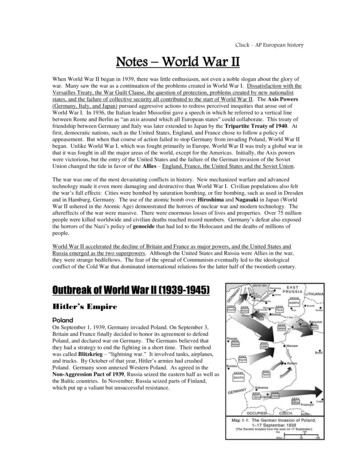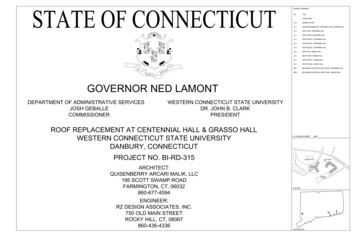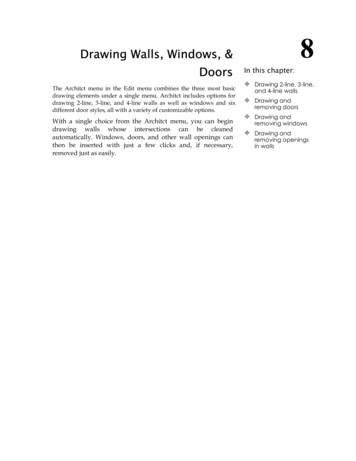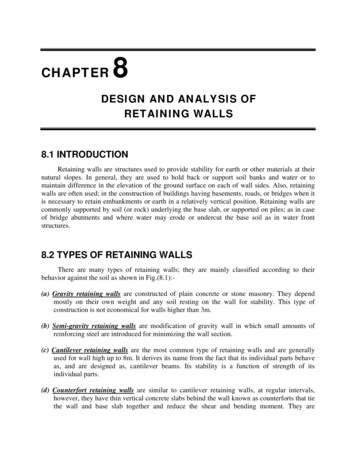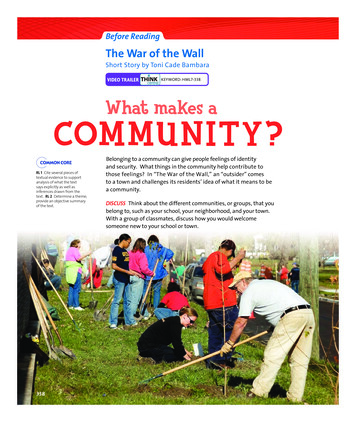
Transcription
Before ReadingThe War of the WallShort Story by Toni Cade BambaraVIDEO TRAILERKEYWORD: HML7-338What makes aCOMMUNITY?RL 1 Cite several pieces oftextual evidence to supportanalysis of what the textsays explicitly as well asinferences drawn from thetext. RL 2 Determine a theme;provide an objective summaryof the text.Belonging to a community can give people feelings of identityand security. What things in the community help contribute tothose feelings? In “The War of the Wall,” an “outsider” comesto a town and challenges its residents’ idea of what it means to bea community.DISCUSS Think about the different communities, or groups, that youbelong to, such as your school, your neighborhood, and your town.With a group of classmates, discuss how you would welcomesomeone new to your school or town.338338-339 NA L07PE-u03s2-brWarW.indd 3381/8/11 12:58:41 AM
Meet the Authortext analysis: multiple themesA story usually has one main theme, but it may also haveother themes. To determine the story’s theme or themes, note the setting of the story and how it might relate tothe plot and characters make inferences about character motivations andrelationships note what conflicts arise and how they are resolvedA theme may be indicated through the lessons learned bythe characters in a particular setting. As you read “War ofthe Wall,” keep these tips in mind in order to identify thestory’s themes.reading strategy: monitorActive readers check, or monitor, their understanding asthey read. One way to monitor your understanding is topause occasionally and ask yourself questions. Sometimesyou’ll need to reread to find the answer. Other times you’llwant to read on, because your question might be answeredlater in the story. Either way, asking questions will help youfocus on and better understand what you are reading.As you read “The War of the Wall,” record questionsand answers about what is happening and why charactersact the way they do. Use a chart like the one shown.My QuestionsAnswersWhat is the lady painting on the wall?vocabulary in contextThe following phrases could be newspaper headlinesfor articles about the artist’s painting in “The War ofthe Wall.” Write a definition of each boldfaced word.1.2.3.4.5.Aroma of Paint Was Promise of Future BeautyArtist’s Masterpiece Creates SensationViewers in Trance over Splendid WorkColors and Subject Matter Beckon to Wide AudienceInscription on Mural Provides DedicationToni Cade Bambara1939–1995Creative BeginningsBorn Miltona Mirkin Cade, Toni CadeBambara announced at five years oldthat she was changing her name toToni. Her mother, who supported allof Bambara’s creative efforts, agreed.Bambara began writing as a childand never stopped. She went on tobecome an award-winning author,teacher, filmmaker, and a leadingactivist in the African-Americancommunity. Although set in a smalltown, “The War of the Wall” wasinspired by Bambara’s memoriesof growing up in the Harlemneighborhood of New York City.background to the storyMuralsA mural is a large picture painted on aninterior or exterior wall of a building.Many murals illustrate scenes fromhistory or reflect the people of localcommunities. In the 1960s, AfricanAmerican artists began a “wall ofrespect” movement. They paintedmurals as symbols of their respectfor different groups. Walls of respectappeared everywhere from Easterncities such as New York to Westerncities such as Los Angeles. They werealso painted in small Southern townssuch as the one in which “The War ofthe Wall” takes place.AuthorOnlineGo to thinkcentral.com.l.com.Complete the activities in your Reader/Writer Notebook.KEYWORD: HML7-33939339338-339 NA L07PE-u03s2-brWarW.indd 3391/8/11 12:58:47 AM
thewar f theollaWToni Cade Bambarae and Lou had no time for courtesies. We were late for school.So we just flat out told the painter lady to quit messing with thewall. It was our wall, and she had no right coming into our neighborhood painting on it. Stirring in the paint bucket and not even lookingat us, she mumbled something about Mr. Eubanks, the barber, givingher permission. That had nothing to do with it as far as we wereconcerned. We’ve been pitching pennies against that wall since we werelittle kids. Old folks have been dragging their chairs out to sit in theshade of the wall for years. Big kids have been playing handball againstthe wall since so-called integration1 when the crazies ’cross town pouredcement in our pool so we couldn’t use it. I’d sprained my neck one timeboosting my cousin Lou up to chisel Jimmy Lyons’s name into the wallwhen we found out he was never coming home from the war in Vietnamto take us fishing. a“If you lean close,” Lou said, leaning hipshot against her beat-up car,“you’ll get a whiff of bubble gum and kids’ sweat. And that’ll tell yousomething—that this wall belongs to the kids of Taliaferro Street.”I thought Lou sounded very convincing. But the painter lady paidus no mind. She just snapped the brim of her straw hat down andhauled her bucket up the ladder.“You’re not even from around here,” I hollered up after her. The licenseplates on her old piece of car said “New York.” Lou dragged me awaybecause I was about to grab hold of that ladder and shake it. And thenwe’d really be late for school.M1020Look closely at thispicture. What details ofsetting does it include?aMULTIPLE THEMESAfter reading the firstfew lines of this story,what do you think themain conflict will be?As you continue reading,think about whatmessage this conflictmight communicate.hen we came from school, the wall was slick with white. Thepainter lady was running string across the wall and taping it hereand there. Me and Lou leaned against the gumball machine outside thepool hall and watched. She had strings up and down and back and forth.Then she began chalking them with a hunk of blue chalk.W1. since so-called integration: from the time in the 1960s when segregation, the separation of the races in publicplaces, was outlawed. The narrator is being sarcastic, suggesting that integration has not been successful.340Detail of Harlem Street Scene (1942),Jacob Lawrence. Gouache on paper,21 20¾ . Private collection. 2008 The Jacob and GwendolynLawrence Foundation, Seattle/ArtistsRights Society (ARS), New York.unit 3: understanding theme340-346 NA L07PE-u03s2-WarW.indd 3401/8/11 12:59:08 AM
the war of the wall340-346 NA L07PE-u03s2-WarW.indd 3413411/8/11 12:59:20 AM
3040506070The Morris twins crossed the street, hanging back at the curb nextto the beat-up car. The twin with the red ribbons was hugging a jug ofcloudy lemonade. The one with yellow ribbons was holding a plate ofdinner away from her dress. The painter lady began snapping the strings.The blue chalk dust measured off halves and quarters up and down andsideways too. Lou was about to say how hip it all was, but I dropped mybook satchel on his toes to remind him we were at war.Some good aromas were drifting our way from the plate leaking potlikker2 onto the Morris girl’s white socks. I could tell from where I stoodthat under the tinfoil was baked ham, collard greens, and candied yams.And knowing Mrs. Morris, who sometimes bakes for my mama’s restaurant,a slab of buttered cornbread was probably up under there too, sopping upsome of the pot likker. Me and Lou rolled our eyes, wishing somebodywould send us some dinner. But the painter lady didn’t even turn around.She was pulling the strings down and prying bits of tape loose.Side Pocket came strolling out of the pool hall to see what Lou and mewere studying so hard. He gave the painter lady the once-over, checkingout her paint-spattered jeans, her chalky T-shirt, her floppy-brimmedstraw hat. He hitched up his pants and glided over toward the painterlady, who kept right on with what she was doing.“Whatcha got there, sweetheart?” he asked the twin with the plate.“Suppah,” she said all soft and countrylike.“For her,” the one with the jug added, jerking her chin toward thepainter lady’s back.Still she didn’t turn around. She was rearing back on her heels, herhands jammed into her back pockets, her face squinched up like themasterpiece she had in mind was taking shape on the wall by magic.We could have been gophers crawled up into a rotten hollow for all shecared. She didn’t even say hello to anybody. Lou was mutteringsomething about how great her concentration was. I butt him withmy hip, and his elbow slid off the gum machine. b“Good evening,” Side Pocket said in his best ain’t-I-fine voice. Butthe painter lady was moving from the milk crate to the step stool to theladder, moving up and down fast, scribbling all over the wall like a crazyperson. We looked at Side Pocket. He looked at the twins. The twinslooked at us. The painter lady was giving a show. It was like those oldtimey music movies where the dancer taps on the tabletop and then startsjumping all over the furniture, kicking chairs over and not skipping a beat.She didn’t even look where she was stepping. And for a minute there,hanging on the ladder to reach a far spot, she looked like she was goingto tip right over.aroma (E-rIPmE) n.a smell; odorLanguage CoachHomonyms Wordsthat are spelled andpronounced the samebut have differentmeanings are calledhomonyms. Rereadlines 35–36 and 59–60.The word hip can mean“joint connecting theleg to the waist” or“stylish.” Use contextclues to figure outthe meaning for eachsentence.masterpiece(mBsPtEr-pCsQ) n.a great work of artbMONITORWhy do you think thenarrator says, “We couldhave been gophers . . .for all she cared”? Howis the narrator feeling?2. pot likker: the broth or liquid in which meat or vegetables have been cooked.342unit 3: understanding theme340-346 NA L07PE-u03s2-WarW.indd 3421/8/11 12:59:22 AM
80“Ahh,” Side Pocket cleared his throat and moved fast to catch theladder. “These young ladies here have brought you some supper.”“Ma’am?” The twins stepped forward. Finally the painter turned around,her eyes “full of sky,” as my grandmama would say. Then she stepped downlike she was in a trance. She wiped her hands on her jeans as the Morristwins offered up the plate and the jug. She rolled back the tinfoil, thenwagged her head as though something terrible was on the plate.“Thank your mother very much,” she said, sounding like her mouthwas full of sky too. “I’ve brought my own dinner along.” And then,without even excusing herself, she went back up the ladder, drawingon the wall in a wild way. Side Pocket whistled one of those oh-brotherbreathy whistles and went back into the pool hall. The Morris twinsshifted their weight from one foot to the other, then crossed the streetand went home. Lou had to drag me away, I was so mad. We couldn’twait to get to the firehouse to tell my daddy all about this rude womanwho’d stolen our wall.trance (trBns) n.a condition ofdaydreaming orbeing unconsciousof one’s surroundingsll the way back to the block to help my mama out at the restaurant,me and Lou kept asking my daddy for ways to run the painter ladyout of town. But my daddy was busy talking about the trip to the countryand telling Lou he could come too because Grandmama can always usean extra pair of hands on the farm.Later that night, while me and Lou were in the back doing our chores,we found out that the painter lady was a liar. She came into the restaurantand leaned against the glass of the steam table, talking about how starvedshe was. I was scrubbing pots and Lou was chopping onions, but we couldhear her through the service window. She was asking Mama was that aham hock in the greens, and was that a neck bone in the pole beans, andwere there any vegetables cooked without meat, especially pork.“I don’t care who your spiritual leader is,” Mama said in that way ofhers. “If you eat in the community, sistuh, you gonna eat pig by-and-by,one way or t’other.”Me and Lou were cracking up in the kitchen, and several customersat the counter were clearing their throats, waiting for Mama to really fixher wagon3 for not speaking to the elders when she came in. The painterlady took a stool at the counter and went right on with her questions.Was there cheese in the baked macaroni, she wanted to know? Werethere eggs in the salad? Was it honey or sugar in the iced tea? Mama wasfixing Pop Johnson’s plate. And every time the painter lady asked a foolquestion, Mama would dump another spoonful of rice on the pile. Shewas tapping her foot and heating up in a dangerous way. But Pop JohnsonA901001103. fix her wagon: a slang expression meaning “put her in her place; bring about her downfall.”the war of the wall340-346 NA L07PE-u03s2-WarW.indd 3433431/8/11 12:59:22 AM
120130140150was happy as he could be. Me and Lou peeked through the servicewindow, wondering what planet the painter lady came from. Who everheard of baked macaroni without cheese, or potato salad without eggs? c“Do you have any bread made with unbleached flour?” the painterlady asked Mama. There was a long pause, as though everybody in therestaurant was holding their breath, wondering if Mama would dumpthe next spoonful on the painter lady’s head. She didn’t. But when sheset Pop Johnson’s plate down, it came down with a bang.When Mama finally took her order, the starving lady all of a suddencouldn’t make up her mind whether she wanted a vegetable plate or fishand a salad. She finally settled on the broiled trout and a tossed salad.But just when Mama reached for a plate to serve her, the painter ladyleaned over the counter with her finger all up in the air.“Excuse me,” she said. “One more thing.” Mama was holding theplate like a Frisbee, tapping that foot, one hand on her hip. “Can I getraw beets in that tossed salad?”“You will get,” Mama said, leaning her face close to the painter lady’s,“whatever Lou back there tossed. Now sit down.” And the painter ladysat back down on her stool and shut right up. dAll the way to the country, me and Lou tried to get Mama to openfire on the painter lady. But Mama said that seeing as how she was fromthe North, you couldn’t expect her to have any manners. Then Mamasaid she was sorry she’d been so impatient with the woman because sheseemed like a decent person and was simply trying to stick to a verystrict diet. Me and Lou didn’t want to hear that. Who did that lady thinkshe was, coming into our neighborhood and taking over our wall? e“Wellllll,” Mama drawled, pulling into the filling station so Daddy couldtake the wheel, “it’s hard on an artist, ya know. They can’t always get peopleto look at their work. So she’s just doing her work in the open, that’s all.”Me and Lou definitely did not want to hear that. Why couldn’t she setup an easel downtown or draw on the sidewalk in her own neighborhood?Mama told us to quit fussing so much; she was tired and wanted to rest.She climbed into the back seat and dropped down into the warm hollowDaddy had made in the pillow.All weekend long, me and Lou tried to scheme up ways to recapture ourwall. Daddy and Mama said they were sick of hearing about it. Grandmamaturned up the TV to drown us out. On the late news was a story about theNew York subways. When a train came roaring into the station all coveredfrom top to bottom, windows too, with writings and drawings done withspray paint, me and Lou slapped five. Mama said it was too bad kids inNew York had nothing better to do than spray paint all over the trains.Daddy said that in the cities, even grown-ups wrote all over the trains andbuildings too. Daddy called it “graffiti.” Grandmama called it a shame.344MULTIPLE THEMEScReread lines 96–113.How is the painterdifferent from thepeople who live inthe community?MONITORdWhat questions doyou have about whatis happening in thisscene? Record them inyour monitoring chart.RL 2eMULTIPLE THEMESSetting is the time andplace where a storyhappens. Setting caninfluence a story inseveral ways. It canaffect how charactersact and it can even causea conflict. Reread lines130–136. What does thesetting have to do withthe conflict betweenthe community and thepainter?unit 3: understanding theme340-346 NA L07PE-u03s2-WarW.indd 3441/8/11 12:59:22 AM
e couldn’t wait to get out of school on Monday. We couldn’t findany black spray paint anywhere. But in a junky hardware storedowntown we found a can of white epoxy4 paint, the kind you touch upold refrigerators with when they get splotchy and peely. We spent ourwhole allowance on it. And because it was too late to use our bus passes,we had to walk all the way home lugging our book satchels and gymshoes, and the bag with the epoxy.When we reached the corner of Taliaferro and Fifth, it looked likea block party or something. Half the neighborhood was gathered onthe sidewalk in front of the wall. I looked at Lou, he looked at me. Weboth looked at the bag with the epoxy and wondered how we were goingto work our scheme. The painter lady’s car was nowhere in sight. Butthere were too many people standing around to do anything. Side Pocketand his buddies were leaning on their cue sticks, hunching each other.Daddy was there with a lineman5 he catches a ride with on Mondays.Mrs. Morris had her arms flung around the shoulders of the twins oneither side of her. Mama was talking with some of her customers, manyof them with napkins still at the throat. Mr. Eubanks came out of thebarbershop, followed by a man in a striped poncho, half his face shaved,the other half full of foam.“She really did it, didn’t she?” Mr. Eubanks huffed out his chest.Lots of folks answered right quick that she surely did when they sawthe straight razor in his hand. fMama beckoned us over. And then we saw it. The wall. Reds, greens,figures outlined in black. Swirls of purple and orange. Storms of blues andyellows. It was something. I recognized some of the faces right off. Therewas Martin Luther King, Jr. And there was a man with glasses on and hismouth open like he was laying down a heavy rap. Daddy came up alongsideand reminded us that that was Minister Malcolm X. The serious womanwith a rifle I knew was Harriet Tubman because my grandmama has picturesW160170180fMONITORReread lines 171–176.Why do people agreewith Mr. Eubanksso quickly?beckon (bDkPEn) v. tosummon or call, usuallyby a gesture or nod4. epoxy (G-pJkPsC): a plastic used in glues and paints.5. lineman: a person who repairs telephone or power lines.340-346 NA L07PE-u03s2-WarW.indd 345 Andre Jenny/Alamy.1/8/11 12:59:25 AM
190200210of her all over the house. And I knew Mrs. Fannie Lou Hamer ’causea signed photograph of her hangs in the restaurant next to the calendar.Then I let my eyes follow what looked like a vine. It trailed past a manwith a horn, a woman with a big white flower in her hair, a handsomedude in a tuxedo seated at a piano, and a man with a goatee holdinga book. When I looked more closely, I realized that what had looked likeflowers were really faces. One face with yellow petals looked just likeFrieda Morris. One with red petals looked just like Hattie Morris.I could hardly believe my eyes.“Notice,” Side Pocket said, stepping close to the wall with his cuestick like a classroom pointer. “These are the flags of liberation,” he saidin a voice I’d never heard him use before. We all stepped closer while hepointed and spoke. “Red, black and green,” he said, his pointer falling onthe leaflike flags of the vine. “Our liberation flag.6 And here Ghana, thereTanzania. Guinea-Bissau, Angola, Mozambique.”7 Side Pocket soundedvery tall, as though he’d been waiting all his life to give this lesson.Mama tapped us on the shoulder and pointed to a high section of thewall. There was a fierce-looking man with his arms crossed against hischest guarding a bunch of children. His muscles bulged, and he lookeda lot like my daddy. One kid was looking at a row of books. Lou hunchedme ’cause the kid looked like me. The one that looked like Lou wasspinning a globe on the tip of his finger like a basketball. There wereother kids there with microscopes and compasses. And the more I looked,the more it looked like the fierce man was not so much guarding the kidsas defending their right to do what they were doing. gThen Lou gasped and dropped the paint bag and ran forward, runninghis hands over a rainbow. He had to tiptoe and stretch to do it, it wasso high. I couldn’t breathe either. The painter lady had found the chiselmarks and had painted Jimmy Lyons’s name in a rainbow.“Read the inscription, honey,” Mrs. Morris said, urging little Friedaforward. She didn’t have to urge much. Frieda marched right up, bentdown, and in a loud voice that made everybody quit oohing and ahhingand listen, she read,To the People of Taliaferro StreetI Dedicate This Wall of RespectPainted in Memory of My CousinJimmy Lyons 220SOCIAL STUDIESCONNECTIONMartin Luther King Jr.,Malcolm X, HarrietTubman, and FannieLou Hamer (shownhere) were all AfricanAmericans whofought for freedomand equality.gMULTIPLE THEMESReread lines 200–208.Here you see the story’smain characters throughthe painter’s eyes. Howdoes this show thatshe understands thecommunity?inscription(Gn-skrGpPshEn) n.something written,carved, or engravedon a surface6. Red, black and green . . . liberation flag: a banner of red, black, and green horizontal stripeshas been used in the United States as well as Africa to stand for the liberation, or freedom,sought by people of African heritage.7. Ghana . . . Tanzania. Guinea-Bissau, Angola, Mozambique (mIQzEm-bCkP): countriesin southern and western Africa.346unit 3: understanding theme340-346 NA L07PE-u03s2-WarW.indd 3461/8/11 12:59:27 AM
After ReadingComprehension1. Recall Why is the wall special to the narrator and Lou?2. Represent Who is related to whom in this story? Use web diagramsto show the family relationships mentioned.3. Clarify Why don’t Lou and the narrator carry out their plan to recapturethe wall?RL 1 Cite several pieces of textualevidence to support analysis ofwhat the text says explicitly aswell as inferences drawn from thetext. RL 2 Determine a theme;provide an objective summary ofthe text.Text Analysis4. Monitor Review the chart you filled in as you read. Which questions andanswers were most important for understanding the story? Why?5. Make Inferences Reread lines 210–220. How do you think the two boysfeel about having bought paint once they read the inscription on thewall? Explain.6. Analyze Characters Mama’s reaction to the painter seems to change overthe course of the story. Her first impression of the painter seems to benegative. Why does she then defend the painter to the narrator and Lou?7. Identify Multiple Themes Summarize what the characters learn aboutthemselves and the painter. Then tell what you think is the main theme ofthe story. Then identify another theme in the story. Explain your answers.8. Evaluate Was the painter an outsider or part of the community? Explain.Extension and Challenge9. Readers’ Circle “The War of the Wall” is told from the first-person pointof view. Everything we learn about the characters and plot comes fromwhat the narrator chooses to tell us. For that reason, we don’t know verymuch about the painter’s thoughts and feelings. With a small group ofclassmates, talk about what the painter may have been thinking aboutthe community. Support your responses with evidence from the story.10.SOCIAL STUDIES CONNECTION Read the article “Back to the Wall”on page 349 about artist Judith Baca’s mural restoration project.Identify similarities and differences between Los Angeles’s Great Wall andthe mural in the story. Think about the subject of each mural and the wayeach was created.What makes a COMMUNITY?Describe a community or group to which you belong.the war of the wall347-348 NA L07PE-u03s2-arWarW.indd 3473471/8/11 12:59:54 AM
Vocabulary in Contextvocabulary practiceChoose the letter of the situation that you would associate with eachboldfaced vocabulary word.1. aroma: (a) arguing with a friend, (b) writing a letter, (c) smelling a rose2. masterpiece: (a) a game of catch, (b) a prize-winning play, (c) a stormy day3. trance: (a) walking a dog, (b) snoring loudly, (c) not paying attention4. beckon: (a) hailing a taxicab, (b) passing a test, (c) eating lunch5. inscription: (a) military service, (b) words on a tombstone, (c) parts of a cararomabeckoninscriptionmasterpiecetra nceacademic vocabulary in speaking clause context cultural symbol themeThe author of “War of the Wall” uses many cultural references, such as a wallwhere kids play handball and a pool hall, to make the neighborhood come tolife. With a small group, discuss which references had the most impact on thestory. Use at least one of the Academic Vocabulary words in your discussion.vocabulary strategy: denotations and connotationsA word’s denotation is its literal meaning—that is, the meaning foundin a dictionary definition. A word’s connotation comes from the shadesof meaning it has beyond its definition. For example, a stubborn person couldalso be described as strong-willed or pig-headed. But strong-willed connotes“independent in thinking and acting,” while pig-headed connotes “inflexible.”The context of a phrase, sentence, or paragraph can sometimes help youdetermine the connotation of a word.L 5c Distinguish amongconnotations of words with similardenotations. L 6 Acquire anduse accurately grade-appropriategeneral academic words.PRACTICE Use the context in the following sentence pairs to determine theconnotation of each boldfaced word.1. There was a gathering of neighbors in the street to welcome the soldier.2. An angry mob appeared in front of the courthouse to protest the verdict.3. Her slender frame allows her to wear many different styles of clothing.4. His skinny build prevented him from playing football.5. People admired Joel for his self-confidence.6. Mya is arrogant and thinks she’s the only one who makes good decisions.348InteractiveVocabularyGo to thinkcentral.com.KEYWORD: HML7-348unit 3: understanding theme347-348 NA L07PE-u03s2-arWarW.indd 3481/8/11 12:59:55 AM
Reading for InformationMAGAZINE ARTICLE In “The War of the Wall,” a woman paints a mural in a Southerntown. In the following article, you’ll read about the real-life artist Judith Baca and thepeople who helped her create and restore a large mural in Los Angeles, California.Judith F. Baca, Triumph of the Hearts from World Wall: A Vision of The Future Without Fear,1986–present. SPARC/www.sparcmurals.com.Back to the WallWfrom People Weeklyorking in a city known more forfreeways than museums, JudithBaca may be the quintessential Los Angelesartist, painting not on canvas but onconcrete. Since 1974 she has overseen thecreation of roughly 550 murals in publicspaces, providing summer work for innercity kids while she brings color and life tohighway underpasses and parks. “I want itto continue,” Baca, 58, says of her work.“I want future generations to see it.”One of her most famous pieces isthe 13-foot-high, half-mile-long GreatWall, which depicts world and L.A. history on a flood-channel wall. Some 400youths—many from poor, crime-riddenareas—worked on the mural, and 30years later, some of their kids workedon its restoration. “People come firstfor Judy,” says Priscilla Becker, 40, who,as a teen from a poor family, workedwith Baca for three summers. Now CEOof a software company, Becker adds,“From Judy I learned that dreams arenot just dreams.”Baca was teaching art in an innercity park when she began planningmurals to build bridges between rivalgangs. She still wants her projects tomeet the same goal. “All these people madethe wall together,” she says. “That’s thestory—what they made together.”reading for information349-349 NA L07PE-u03s2-c2Wall.indd 3493491/8/11 1:00:14 AM
such as the one in which “The War of the Wall” takes place. text analysis: multiple themes A story usually has one main theme, but it may also have other themes. To determine the story’s theme or themes, note the setting of the story and how it might relate to the plot and cha



